Redesigning In-Flight Service with Service Blueprint Based on Text Analysis
Abstract
1. Introduction
2. Related Review and Knowledge
2.1. Service Blueprint Based Redesign
2.2. Reorganizing Service Encounters in Service Blueprint
2.3. Prior Works and Benchmark of the In-Flight Service Process
3. Methodology
3.1. Research Model
3.2. Data
4. Results
4.1. Service Encounters Using LDA Modeling
4.2. Service Blueprinting in Terms of Complexity
4.3. Service Blueprinting in Terms of Divergence
4.4. Redesigned In-Flight Service Blueprint
5. Summary and Conclusions
Author Contributions
Funding
Acknowledgments
Conflicts of Interest
Appendix A
| Service Encounter | Definition | Physical Evidence | Remarks |
|---|---|---|---|
| Boarding a plane | The moment when a meeting with passengers takes place for the first time | Crew uniform, boarding area facilities, aircraft outlook | |
| Finding seats | Checking in boarding passes managing congested aisles | Boarding pass, seat, interior | |
| Baggage service | Managing luggage storages | Overhead compartment (bin), coat room | |
| Ground service | Providing background music, reading materials and beverages | Screen, book, audio | |
| Taking off | Checking up take-off demonstrating safety simulation | Individual reading light, seat belt, in-flight light | |
| In-flight food service | Providing meal and beverage service | Menu, meal, beverage, waiting, service evidence, clearance, attendants’ appearance | Long-haul & international routes |
| In-flight sales | Providing convenience of shopping for passengers | In-flight sales counter, goods | Long-haul & international routes |
| Prepare immigration documents | Support with filling out passenger immigration documents | Immigration documents | International routes |
| Movie watching | Providing movies and music | Passenger service unit (PSU), movie, screen | Long-haul & international routes |
| Personal relaxing | Touring the cabin, responding to service calls | In-flight environment, thermostat setting, toilet, blanket, cushion | |
| Prepare landing | Providing destination information, collecting service items | Earphone, pillow | Long-haul & international routes |
| Landing | Checking safety of landing | Individual reading light, in-flight light, seat | |
| Deplaning | Giving a farewell and taking back goods | Attendant appearance, cabin interior |
Appendix B
| T1 | T2 | T3 | T4 | T5 | T6 | ||||||
| Passenger relaxation | Boarding | Reservation | Deplaning | Pre-boarding | Meal Service | ||||||
| 5.53% | 5.54% | 5.53% | 5.46% | 5.56% | 5.55% | ||||||
| food | 8.94% | economy | 8.69% | comfort | 9.20% | excel | 14.81% | travel | 11.38% | service | 17.67% |
| change | 7.09% | cabin | 6.75% | staff | 7.09% | leg | 5.74% | food | 10.28% | meal | 7.14% |
| hope | 5.22% | seat | 5.71% | little | 5.85% | try | 4.17% | delay | 7.73% | busy | 6.16% |
| upgrade | 4.69% | disappoint | 5.48% | choose | 4.89% | class | 3.96% | serve | 7.08% | love | 2.11% |
| board | 4.37% | high | 2.31% | steward | 4.88% | bad | 3.30% | quit | 5.97% | return | 1.32% |
| easy | 2.99% | forward | 2.18% | special | 4.50% | friendly | 3.11% | haul | 5.04% | legroom | 1.19% |
| appreciate | 2.37% | issue | 2.01% | left | 4.42% | smile | 2.66% | find | 4.92% | wine | 1.18% |
| bed | 2.35% | several | 1.89% | free | 4.40% | welcome | 2.62% | long | 3.17% | snack | 1.00% |
| premiumeconomy | 2.32% | order | 1.74% | poor | 3.65% | destination | 2.07% | toilet | 2.34% | nice | 0.93% |
| sleep | 1.52% | level | 1.62% | trip | 2.72% | improve | 1.94% | passport | 2.31% | awesome | 0.93% |
| direct | 1.48% | menu | 1.25% | superb | 2.70% | start | 1.94% | bar | 2.30% | number | 0.83% |
| future | 1.30% | glad | 1.21% | show | 2.18% | transfer | 1.68% | route | 2.21% | schedule | 0.63% |
| leg | 1.13% | put | 1.17% | awesome | 1.99% | miss | 1.19% | staff | 1.98% | case | 0.61% |
| bag | 0.58% | gate | 1.10% | start | 1.62% | regret | 1.16% | screen | 1.50% | prefect | 0.52% |
| apology | 0.55% | leave | 0.92% | front | 1.57% | hotel | 1.16% | carrier | 1.20% | available | 0.41% |
| 46.95% | 44.07% | 61.71% | 51.56% | 69.47% | 42.69% | ||||||
| T7 | T8 | T9 | T10 | T11 | T12 | ||||||
| Pre-boarding | Passenger relaxation | Pre-boarding | Passenger relaxation | Passenger relaxation | Reservation | ||||||
| 5.64% | 5.52% | 5.53% | 5.61% | 5.59% | 5.54% | ||||||
| great | 13.10% | entertainment | 21.84% | service | 12.27% | 13.61% | 10.13% | make | 9.46% | seat | 13.61% |
| service | 8.42% | book | 7.71% | experience | 8.32% | 8.92% | 8.66% | good | 6.33% | clean | 8.92% |
| nice | 5.05% | enjoy | 4.67% | passenger | 7.44% | 6.59% | 6.85% | staff | 6.16% | offer | 6.59% |
| kind | 4.70% | give | 3.79% | price | 6.04% | 4.71% | 4.49% | feel | 5.54% | expect | 4.71% |
| ticket | 4.67% | pay | 3.25% | efficient | 4.99% | 4.30% | 3.32% | happy | 5.01% | share | 4.30% |
| ground | 4.63% | pleasant | 2.36% | bag | 4.99% | 4.14% | 3.23% | comfort | 4.60% | option | 4.14% |
| average | 2.32% | problem | 2.36% | sorry | 3.19% | 4.14% | 2.77% | reason | 4.43% | luggage | 4.14% |
| fantastic | 2.19% | perfect | 2.15% | frequent | 3.10% | 3.68% | 2.23% | top | 4.23% | polite | 3.68% |
| return | 1.57% | quick | 2.03% | ticket | 3.10% | 3.21% | 2.22% | home | 4.07% | travel | 3.21% |
| eat | 1.21% | nice | 1.97% | fault | 2.54% | 3.14% | 2.08% | impress | 3.99% | socialmedia | 3.14% |
| system | 1.19% | end | 1.57% | screen | 2.35% | 3.06% | 1.96% | entertainment | 3.32% | route | 3.06% |
| big | 1.07% | meal | 1.47% | recliner | 2.35% | 2.66% | 1.85% | pleasant | 2.75% | detail | 2.66% |
| onboard | 0.93% | facility | 1.21% | luggage | 2.08% | 2.63% | 1.79% | amaze | 2.43% | book | 2.63% |
| water | 0.82% | manage | 1.20% | write | 1.44% | 2.34% | 1.64% | breakfast | 2.20% | decent | 2.34% |
| late | 0.81% | happen | 1.20% | serve | 1.31% | 2.34% | 1.45% | part | 2.05% | pleasure | 2.34% |
| 52.76% | 58.84% | 65.58% | 54.74% | 66.62% | 69.52% | 69.52% | |||||
| T13 | T14 | T15 | T16 | T17 | T18 | ||||||
| Passenger relaxation | Take-off | Take-off | Reservation | Boarding | Passenger relaxation | ||||||
| 5.54% | 5.57% | 5.55% | 5.59% | 5.54% | 5.54% | ||||||
| good | 17.21% | food | 12.39% | airplane | 10.61% | board | 9.45% | check | 14.046 | crew | 11.65% |
| experience | 5.24% | friendly | 5.05% | service | 5.49% | room | 6.86% | airport | 11.275 | arrive | 11.22% |
| attend | 4.19% | choice | 3.52% | drink | 4.84% | connect | 5.04% | lounge | 8.31% | select | 10.77% |
| feedback | 4.07% | review | 2.51% | work | 4.00% | full | 4.71% | quality | 5.09% | space | 8.72% |
| amaze | 3.86% | attendant | 2.33% | compare | 2.47% | found | 3.64% | drink | 4.78% | plenty | 5.74% |
| different | 3.05% | journey | 2.33% | free | 2.34% | professional | 3.08% | available | 4.68% | wait | 4.18% |
| sleep | 2.34% | takeoff | 2.27% | spacious | 2.30% | care | 2.73% | include | 2.70% | start | 2.35% |
| row | 2.30% | departure | 1.84% | point | 2.13% | stopover | 2.35% | legroom | 2.53% | big | 2.26% |
| online | 2.18% | baggage | 1.33% | smooth | 1.92% | smooth | 1.82% | economy | 2.32% | premiumeconomy | 2.21% |
| treat | 1.90% | television | 1.21% | prefect | 1.48% | surprise | 1.31% | short | 2.32% | small | 1.98% |
| huge | 1.26% | request | 1.17% | contact | 1.33% | staff | 1.23% | investigate | 2.26% | room | 1.95% |
| cause | 1.24% | airplane | 1.09% | takeoff | 1.27% | line | 1.21% | please | 2.25% | front | 1.55% |
| terminal | 1.23% | attentive | 0.90% | pretty | 1.21% | flat | 1.20% | fine | 1.28% | film | 1.37% |
| send | 1.21% | good | 0.89% | gate | 1.04% | call | 1.08% | recent | 1.22% | large | 1.23% |
| media | 1.21% | attend | 0.75% | courteous | 0.71% | value | 0.97% | message | 1.14% | pleasant | 1.21% |
| 52.56% | 39.64% | 43.21% | 46.74% | 66.26% | 68.45% | ||||||
Appendix C
| Related Words | % | ||||
|---|---|---|---|---|---|
| Category 1 | Category 2 | ||||
| T1 | - | - | appreciate | 2.37% | 2.4% |
| T2 | forward order put | 5.09% | disappoint glad | 6.69% | 11.8% |
| T3 | staff steward show | 14.15% | comfort special poor superb awesome | 22.04% | 36.2% |
| T4 | - | - | excel bad friendly | 21.22% | 21.2% |
| T5 | serve staff | 9.06% | - | - | 9.1% |
| T6 | service | 17.67% | busy love nice awesome perfect | 11.06% | 22.2% |
| T7 | service | 8.42% | great nice kind fantastic late | 25.85% | 34.3% |
| T8 | entertainment give manage | 26.83% | enjoy pleasant perfect nice | 11.15% | 38.0% |
| T9 | service serve | 13.58% | efficient sorry fault | 10.72% | 24.3% |
| T10 | provide recommend send hostess mention | 11.30% | good worth inconvenient | 14.32% | 25.6% |
| T11 | make staff entertainment | 18.94% | good happy comfort impress pleasant amaze | 25.11% | 44.1% |
| T12 | offer | 6.59% | polite decent pleasure | 8.36% | 15.0% |
| T13 | attend feedback treat send | 10.16% | good amaze | 21.07% | 31.2% |
| T14 | attendant attend | 4.25% | friendly attentive good | 6.84% | 11.1% |
| T15 | service contact | 6.82% | smooth perfect pretty courteous | 5.32% | 12.1% |
| T16 | connect care staff call | 10.08% | professional smooth surprise | 6.21% | 16.3% |
| T17 | check investigate | 16.31% | quality available please fine | 13.31% | 29.6% |
| T18 | crew arrive select wait start | 40.17% | plenty pleasant | 6.95% | 47.1% |
References
- InterVISTAS-ga2 Consulting. The Economic Impact of Air Service Liberization. 2006. Available online: http://www.iata.org/whatwedo/Documents/economics/liberalization_air_transport_study_30may06.pdf (accessed on 30 October 2018).
- Cognizant. How Airlines Can Deliver a Personalized Customer Experience during Operational Disruptions. 2015. Available online: https://www.cognizant.com/whitepapers/How-Airlines-Can-Deliver-a-Personalized-Customer-Experience-During-Operational-Disruptions-codex1603.pdf (accessed on 30 October 2018).
- Bhaskara, V. Airlines Are Giving Customers Exactly What They Want. Forbes. 14 January 2015. Available online: https://www.forbes.com/sites/airchive/2015/01/14/actually-airlines-are-giving-customers-exactly-what-they-want/#3364aaef29bb (accessed on 30 October 2018).
- Treacy, M.; Wiersema, F. Customer Intimacy and Other Value Disciplines Customer Intimacy and Other Value Disciplines. Harv. Bus. Rev. 1993, 71, 84–93. [Google Scholar] [CrossRef]
- Punel, A.; Ermagun, A. Using Twitter network to detect market segments in the airline industry. J. Air Transp. Manag. 2018, 73, 67–76. [Google Scholar] [CrossRef]
- Li, W.; Yu, S.; Pei, H.; Zhao, C.; Tian, B. A hybrid approach based on fuzzy AHP and 2-tuple fuzzy linguistic method for evaluation in-flight service quality. J. Air Transp. Manag. 2017, 60, 49–64. [Google Scholar] [CrossRef]
- Liou, J.J.H.; Yen, L.; Tzeng, G. Using decision rules to achieve mass customization of airline services. Eur. J. Oper. Res. 2010, 205, 680–686. [Google Scholar] [CrossRef]
- Gilbert, D.; Wong, R.K.C. Passenger expectations and airline services: A Hong Kong based study. Tour. Manag. 2003, 24, 519–532. [Google Scholar] [CrossRef]
- Doganis, R. Flying Off Course: Airline Economics and Marketing, 4th ed.; Routledge: London, UK, 2010; ISBN 9780203863992. [Google Scholar]
- Nameghi, E.N.M.; Azmi, A.; Arif, M. The measurement scale for airline hospitality: Cabin crew’s performance perspective. J. Air Transp. Manag. 2013, 30, 1–9. [Google Scholar] [CrossRef]
- Pearlstein, S. Boeing and Airbus, the New ‘Super Duopoly’. The Washington Post. 2018. Available online: https://www.washingtonpost.com/news/wonk/wp/2018/04/25/boeing-and-airbus-the-new-super-duopoly/?noredirect=on&utm_term=.14b4df53ee16 (accessed on 30 October 2018).
- Jones, P.; Clarke-Hill, C.; Comfort, D.; Hillier, D. Marketing and sustainability. Mark. Intell. Plan. 2008, 26, 123–130. [Google Scholar] [CrossRef]
- Ordenes, F.V.; Theodoulidis, B.; Burton, J.; Gruber, T.; Zaki, M. Analyzing Customer Experience Feedback Using Text Mining. J. Serv. Res. 2014, 17, 278–295. [Google Scholar] [CrossRef]
- Mudambi, S.M.; Schuff, D. Research Note: What Makes a Helpful Online Review? A Study of Customer Reviews on Amazon.com. MIS Q. 2010, 34, 185–200. [Google Scholar] [CrossRef]
- Duan, W.; Gu, B.; Whinston, A.B. Do online reviews matter?—An empirical investigation of panel data. Decis. Support Syst. 2008, 45, 1007–1016. [Google Scholar] [CrossRef]
- Dellarocas, C.; Zhang, X.; Awad, N.F. Exploring the value of online product reviews in forecasting sales: The case of motion pictures. J. Interact. Mark. 2007, 21, 23–46. [Google Scholar] [CrossRef]
- Berezina, K.; Bilgihan, A.; Cobanoglu, C.; Okumus, F. Understanding Satisfied and Dissatisfied Hotel Customers: Text Mining of Online Hotel Reviews. J. Hosp. Mark. Manag. 2016, 25, 1–24. [Google Scholar] [CrossRef]
- Mankad, S.; Han, H.; Goh, J.; Gavirneni, S. Understanding Online Hotel Reviews through Automated Text Analysis. Serv. Sci. 2016, 8, 124–138. [Google Scholar] [CrossRef]
- Archak, N.; Ghose, A.; Ipeirotis, P.G. Deriving the Pricing Power of Product Features by Mining Consumer Reviews. Manag. Sci. 2011, 57, 1485–1509. [Google Scholar] [CrossRef]
- Lee, M.J.; Singh, N.; Chan, E.S.W. Service failures and recovery actions in the hotel industry: A text-mining approach. J. Vacat. Mark. 2011, 17, 197–207. [Google Scholar] [CrossRef]
- O’Connor, P. Managing a hotel’s image on Tripadvisor. J. Hosp. Mark. Manag. 2010, 19, 754–772. [Google Scholar] [CrossRef]
- Gretzel, U.; Yoo, K.H. Use and impact of online travel reviews. In Information and Communication Technologies in Tourism 2008; Springer: Berlin, Germany, 2008. [Google Scholar] [CrossRef]
- Pekar, V.; Ou, S. Discovery of subjective evaluations of product features in hotel reviews. J. Vacat. Mark. 2008, 14, 145–155. [Google Scholar] [CrossRef]
- Hu, M.; Liu, B. Mining opinion features in customer reviews. Am. Assoc. Artif. Intell. 2004, 4, 755–760. [Google Scholar] [CrossRef]
- Blei, D.M.; Lafferty, J.D. A correlated topic model of science. Ann. Appl. Stat. 2007, 1, 17–35. [Google Scholar] [CrossRef]
- Blei, D.M.; Ng, A.Y.; Jordan, M.I. Latent Dirichlet Allocation. J. Mach. Learn. Res. 2003, 3, 993–1022. [Google Scholar] [CrossRef]
- Shostack, G.L. Service Positioning through Structural Change. J. Mark. 1987, 51, 34–43. [Google Scholar] [CrossRef]
- Kuang, P.H.; Chou, W.H. Research on Service Blueprint of Food Banks. Des. J. 2017, 20, S3425–S3435. [Google Scholar] [CrossRef]
- Song, W.; Wu, Z.; Li, X.; Xu, Z. Modularizing product extension services: An approach based on modified service blueprint and fuzzy graph. Comput. Ind. Eng. 2015, 85, 186–195. [Google Scholar] [CrossRef]
- Bitner, M.J.; Ostrom, A.L.; Morgan, F.N. Service Blueprinting: A Practical Technique for Service Innovation. Calif. Manag. Rev. 2008, 50, 66–94. [Google Scholar] [CrossRef]
- Tseng, M.M.; Qinhai, M.; Su, C.J. Mapping customers’ service experience for operations improvement. Bus. Process Manag. J. 1999, 5, 50–64. [Google Scholar] [CrossRef]
- Peattie, K.; Belz, F.-M. Sustainability marketing—An innovative conception of marketing. Mark. Rev. St. Gallen 2010, 27, 8–15. [Google Scholar] [CrossRef]
- Polese, F.; Carrubbo, L.; Caputo, F.; Sarno, D. Managing Healthcare Service Ecosystems: Abstracting a Sustainability-Based View from Hospitalization at Home (HaH) Practices. Sustainability 2018, 10, 3951. [Google Scholar] [CrossRef]
- Zeithaml, V.A.; Bitner, M.J.; Gremler, D.D. Services Marketing: Integrating Customer Focus across the Firm, 6th ed.; McGraw-Hill: New York, NY, USA, 2013; ISBN 9780078112058. [Google Scholar]
- Fließ, S.; Kleinaltenkamp, M. Blueprinting the service company—Managing service processes efficiently. J. Bus. Res. 2004, 57, 392–404. [Google Scholar] [CrossRef]
- Shostack, G.L. Designing services that deliver. Harv. Bus. Rev. 1984, 62, 133–139. [Google Scholar] [CrossRef]
- Berkley, B.J. Analyzing service blueprints using phase distributions. Eur. J. Oper. Res. 1996, 88, 152–164. [Google Scholar] [CrossRef]
- Scheuing, E.E.; Christopher, W.F. The Service Quality Handbook; Amacom: New York, NY, USA, 1993; ISBN 9780814401194. [Google Scholar]
- Michel, S. Analyzing service failures and recoveries: A process approach. Int. J. Serv. Ind. Manag. 2001, 12, 20–33. [Google Scholar] [CrossRef]
- Hummel, E.; Murphy, K.S. Using service blueprinting to analyze restaurant service efficiency. Cornell Hosp. Q. 2011, 52, 265–272. [Google Scholar] [CrossRef]
- Buhalis, D.; Law, R. Progress in information technology and tourism management: 20 years on and 10 years after the Internet-The state of eTourism research. Tour. Manag. 2008, 29, 609–623. [Google Scholar] [CrossRef]
- Lee, C.H.; Wang, Y.H.; Trappey, A.J.C. Service design for intelligent parking based on theory of inventive problem solving and service blueprint. Adv. Eng. Inform. 2015, 29, 295–306. [Google Scholar] [CrossRef]
- Ru Chen, H.; Cheng, B. Applying the ISO 9001 process approach and service blueprint to hospital management systems. TQM J. 2012, 24, 418–432. [Google Scholar] [CrossRef]
- Botschen, G.; Bstieler, L.; Woodside, A.G. Sequence-oriented Problem Identification within Service Encounters. J. Euromark. 1996, 5, 19–52. [Google Scholar] [CrossRef]
- Ryu, D.-H.; Lim, C.-H.; Kim, K.-J. Development of online-to-offline service blueprint. In Proceedings of the 2016 Informs Annual Meeting, Nashville, TN, USA, 13–16 November 2016. [Google Scholar]
- Cristobal-Fransi, E.; Daries, N.; Serra-Cantallops, A.; Ramón-Cardona, J.; Zorzano, M. Ski Tourism and Web Marketing Strategies: The Case of Ski Resorts in France and Spain. Sustainability 2018, 10, 2920. [Google Scholar] [CrossRef]
- Hartman, A.; Jain, A.N.; Ramanathan, J.; Ramfos, A. Participatory Design of Public Sector Services. In Proceedings of the 2010 Electronic Government and the Information Systems Perspective (EGOVIS 2010), Bilbao, Spain, 31 August–2 September 2010. [Google Scholar] [CrossRef]
- Patrício, L.; Fisk, R.P.; Falcão e Cunha, J.; Cunha, J. Designing multi-interface service experiences: The service experience blueprint. J. Serv. Res. 2008, 10, 318–334. [Google Scholar] [CrossRef]
- Patrício, L.; Fisk, R.P.; Falcão e Cunha, J.; Constantine, L. Multilevel service design: From customer value constellation to service experience blueprinting. J. Serv. Res. 2011, 14, 180–200. [Google Scholar] [CrossRef]
- Lim, C.-H.; Kim, K.-J. Information Service Blueprint: A Service Blueprinting Framework for Information-Intensive Services. Serv. Sci. 2014, 6, 296–312. [Google Scholar] [CrossRef]
- Pöppel, J.; Finsterwalder, J.; Laycock, R.A. Developing a film-based service experience blueprinting technique. J. Bus. Res. 2018, 85, 459–466. [Google Scholar] [CrossRef]
- Barbieri, S.; Fragniere, E.; de Grandbois, Y.; Moreira, M.P. Measuring Human Risks in Service: A New Model. J. Serv. Sci. Manag. 2017, 10, 518–536. [Google Scholar] [CrossRef]
- Fitzsimmons, J.A.; Fitzsimmons, M.J.; Bordoloi, S. Service Management: Operations, Strategy, and Information Technology, 8th ed.; McGraw-Hill: New York, NY, USA, 2014; ISBN 9780077841201. [Google Scholar]
- Surprenant, C.F.; Solomon, M.R. Predictability and Personalization in the Service Encounter. J. Mark. 1987, 86–96. [Google Scholar] [CrossRef]
- Voorhees, C.M.; Fombelle, P.W.; Gregoire, Y.; Bone, S.; Gustafsson, A.; Sousa, R.; Walkowiak, T. Service encounters, experiences and the customer journey: Defining the field and a call to expand our lens. J. Bus. Res. 2017, 79, 269–280. [Google Scholar] [CrossRef]
- Parasuraman, A.; Zeithaml, V.; Berry, L. Reassessment of expectations as a comparison standard in measuring service quality: Implications for further research. J. Mark. 1994, 111–124. [Google Scholar] [CrossRef]
- Lynn, M.L.; Lytle, R.S.; Bobek, S. Service Orientation in Transitional Markets: Does it matter? Eur. J. Mark. 2000, 34, 279–298. [Google Scholar] [CrossRef]
- Gremler, D.D.; Brown, S.W. The loyalty ripple effect. Int. J. Serv. Ind. Manag. 1999, 10, 271–293. [Google Scholar] [CrossRef]
- Solomon, M.R.; Surprenant, C.; Czepiel, J.A.; Gutman, E.G. Role Theory Perspective on Dyadic Relations: The service encounter. J. Mark. 1985, 49, 99–111. [Google Scholar] [CrossRef]
- Carlzon, J. Moments of Truth; Harper & Row: New York, NY, USA, 1987; ISBN 9780060915803. [Google Scholar]
- Mittal, B.; Lassar, W.M. The role of personalization in service encounters. J. Retail. 1996, 72, 95–109. [Google Scholar] [CrossRef]
- Bitner, M.J.; Booms, B.H.; Tetreault, M.S. The Service Encounter: Diagnosing Favorable and Unfavorable Incidents. J. Mark. 1990, 71–84. [Google Scholar] [CrossRef]
- Wirtz, J.; Heracleous, L. Managing human resources for service excellence and cost effectiveness at Singapore Airlines. Manag. Serv. Qual. 2008, 18, 4–19. [Google Scholar] [CrossRef]
- Paquet, C.; St-Arnaud-McKenzie, D.; Ferland, G.; Dubé, L. A blueprint-based case study analysis of nutrition services provided in a midterm care facility for the elderly. J. Am. Diet. Assoc. 2003, 103, 363–368. [Google Scholar] [CrossRef] [PubMed]
- Kim, H.-W.; Kim, Y.-G. Rationalizing the customer service process. Bus. Process Manag. J. 2001, 7, 139–156. [Google Scholar] [CrossRef]
- Geum, Y.; Park, Y. Designing the sustainable product-service integration: A product-service blueprint approach. J. Clean. Prod. 2011, 19, 1601–1614. [Google Scholar] [CrossRef]
- Hossain, M.Z.; Enam, F.; Farhana, S. Service Blueprint a Tool for Enhancing Service Quality in Restaurant Business. Am. J. Ind. Bus. Manag. 2017, 7, 919–926. [Google Scholar] [CrossRef]
- Gupta, H. Evaluating service quality of airline industry using hybrid best worst method and VIKOR. J. Air Transp. Manag. 2018, 68, 35–47. [Google Scholar] [CrossRef]
- Tsafarakis, S.; Kokotas, T.; Pantouvakis, A. A multiple criteria approach for airline passenger satisfaction measurement and service quality improvement. J. Air Transp. Manag. 2018, 68, 61–75. [Google Scholar] [CrossRef]
- Gursoy, D.; Chen, M.H.; Kim, H.J. The US airlines relative positioning based on attributes of service quality. Tour. Manag. 2005, 26, 57–67. [Google Scholar] [CrossRef]
- Park, J.W.; Robertson, R.; Wu, C.L. The effect of airline service quality on passengers’ behavioural intentions: A Korean case study. J. Air Transp. Manag. 2004, 10, 435–439. [Google Scholar] [CrossRef]
- Tsaura, S.H.; Chang, T.Y.; Yen, C.H. The evaluation of airline service quality by fuzzy MCDM. Tour. Manag. 2002, 23, 107–115. [Google Scholar] [CrossRef]
- Bamford, D.; Xystouri, T. A case study of service failure and recovery within an international airline. Manag. Serv. Qual. 2005, 15, 306–322. [Google Scholar] [CrossRef]
- Kim, I.; Bong, Y.; Cho, M. Service Blueprint of the Young Kids Customers’ Specialized In-flight Service Utilizing Kano Model Analysis. J. Tour. Sci. 2015, 39, 71–90. [Google Scholar]
- Lee, J.-M.; Kim, Y.-S.; Lee, D.-W. Analyzing the Service Blueprint for Aircraft Cabin Service. J. Korean Soc. Qual. Manag. 2010, 38, 593–600. [Google Scholar]
- Go, M.; Kim, I. In-flight NCCI management by combining the Kano model with the service blueprint: A comparison of frequent and infrequent flyers. Tour. Manag. 2018, 69, 471–486. [Google Scholar] [CrossRef]
- Skytrax. Available online: https://skytraxratings.com/ (accessed on 26 October 2018).
- Witell, L.; Kristensson, P.; Gustafsson, A.; Löfgren, M. Idea generation: Customer co-creation versis traditional market research techniques. J. Serv. Manag. 2011, 22, 140–159. [Google Scholar] [CrossRef]
- Wirtz, J.; Kuan Tambyah, S.; Mattila, A.S. Organizational learning from customer feedback received by service employees. J. Serv. Manag. 2010, 21, 363–387. [Google Scholar] [CrossRef]
- Gao, B.; Li, X.; Liu, S.; Fang, D. How power distance affects online hotel ratings: The positive moderating roles of hotel chain and reviewers’ travel experience. Tour. Manag. 2018, 65, 176–186. [Google Scholar] [CrossRef]
- Skytrax. Available online: https://www.worldairlineawards.com/the-worlds-top-100-airlines-2017/ (accessed on 26 October 2018).
- Xiang, Z.; Schwartz, Z.; Gerdes, J.H.; Uysal, M. What can big data and text analytics tell us about hotel guest experience and satisfaction? Int. J. Hosp. Manag. 2015, 44, 120–130. [Google Scholar] [CrossRef]
- Inmarsat Aviation. The Future of Inflight Retail. 2016. Available online: https://www.inmarsataviation.com/en/benefits/revenue-opportunities/the-future-of-inflight-retail.html (accessed on 30 October 2018).
- McMillan, S.; Hwang, J. Measures of Perceived Interactivity: An Exploration of the Role of Direction of Communication, User Control, and Time in Shaping Perceptions of Interactivity. J. Advert. 2002, 31, 29–42. [Google Scholar] [CrossRef]
- Zhong, N.; Li, Y.; Wu, S.T. Effective pattern discovery for text mining. IEEE Trans. Knowl. Data Eng. 2012, 24, 30–44. [Google Scholar] [CrossRef]
- Hoffman, K.D.; Bateson, J.E.G. Services Marketing, 4th ed.; South-Western Cengage Learning: Mason, OH, USA, 2010; ISBN 9781439039397. [Google Scholar]
- Ahrholdt, D.C.; Gudergan, S.P.; Ringle, C.M. Enhancing Service Loyalty: The Roles of Delight, Satisfaction, and Service Quality. J. Travel Res. 2017, 56, 436–450. [Google Scholar] [CrossRef]
- Umashankar, N.; Ward, M.K.; Dahl, D.W. The Benefit of Becoming Friends: Complaining After Service Failures Leads Customers with Strong Ties to increase loyalty. J. Mark. 2017, 81, 79–98. [Google Scholar] [CrossRef]
- Keaveney, S.M. Customer Switching Behavior in Service Industries: An exploratory study. J. Mark. 1995, 59, 71–82. [Google Scholar] [CrossRef]
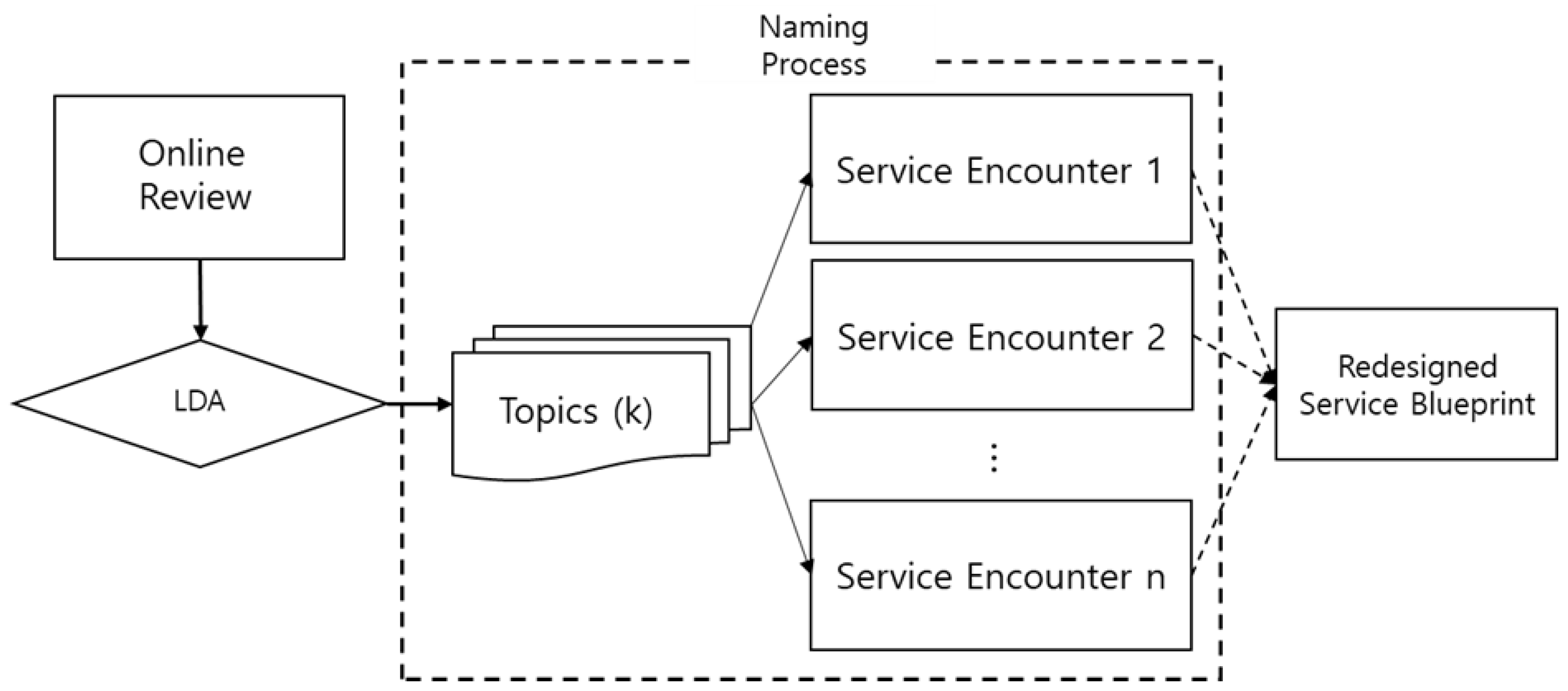
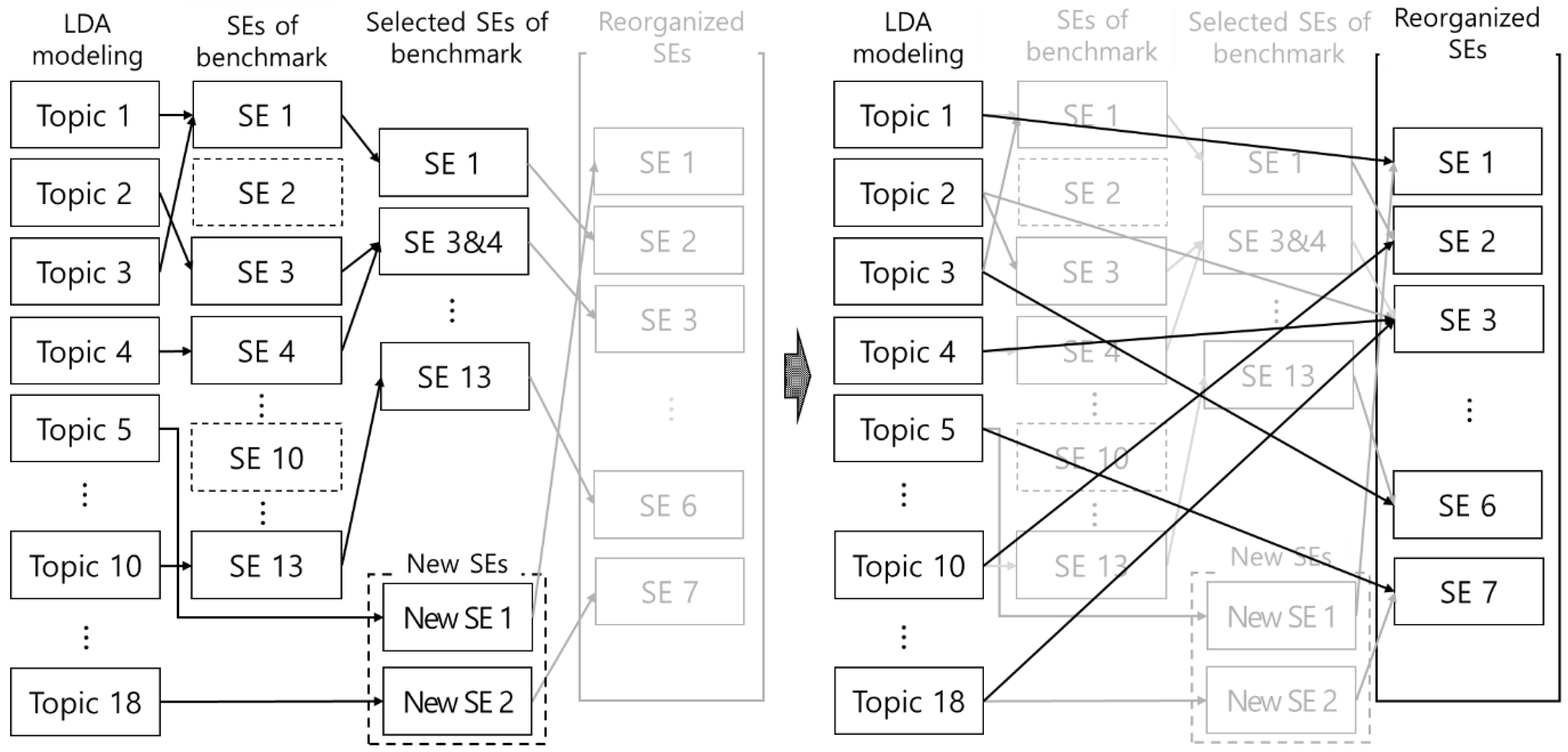
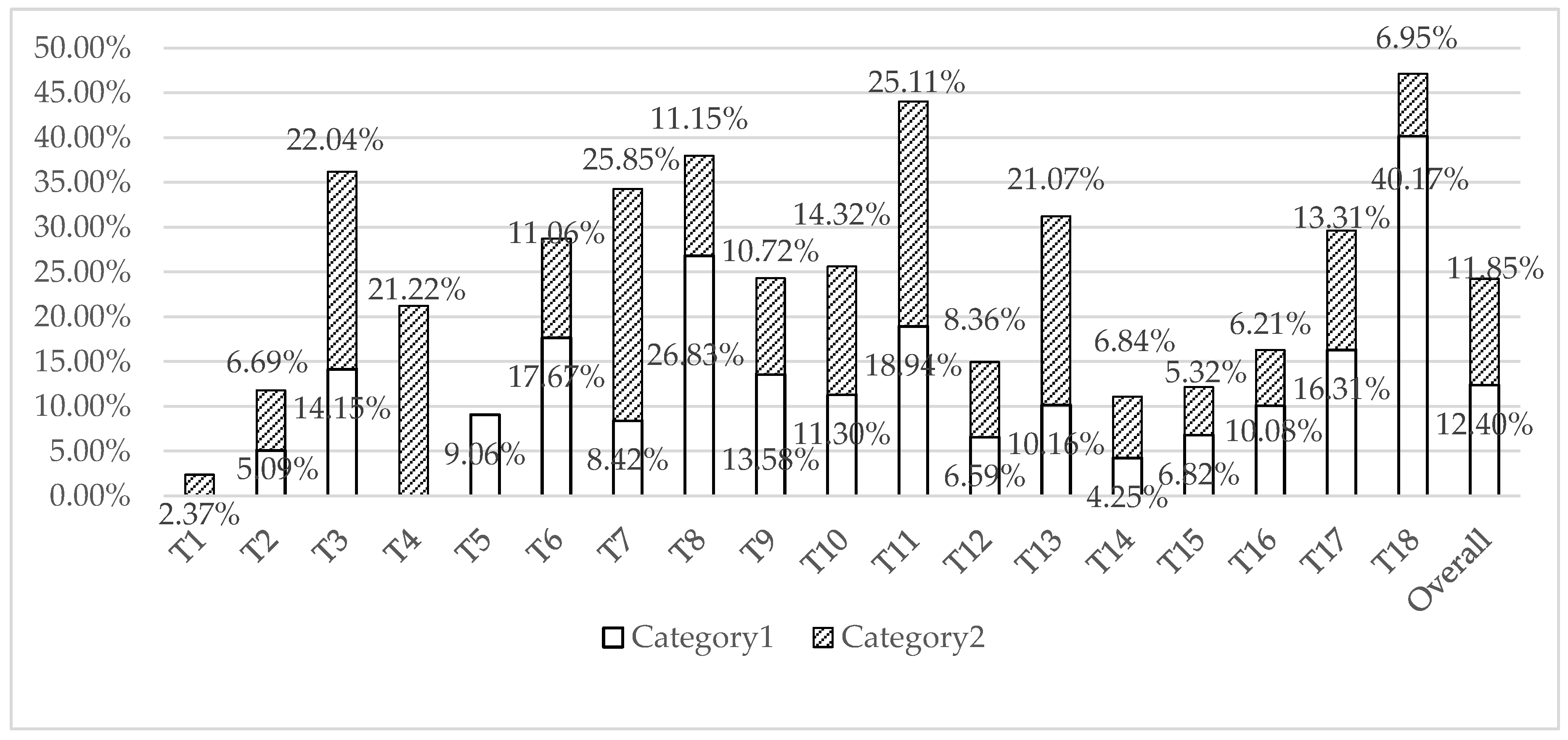
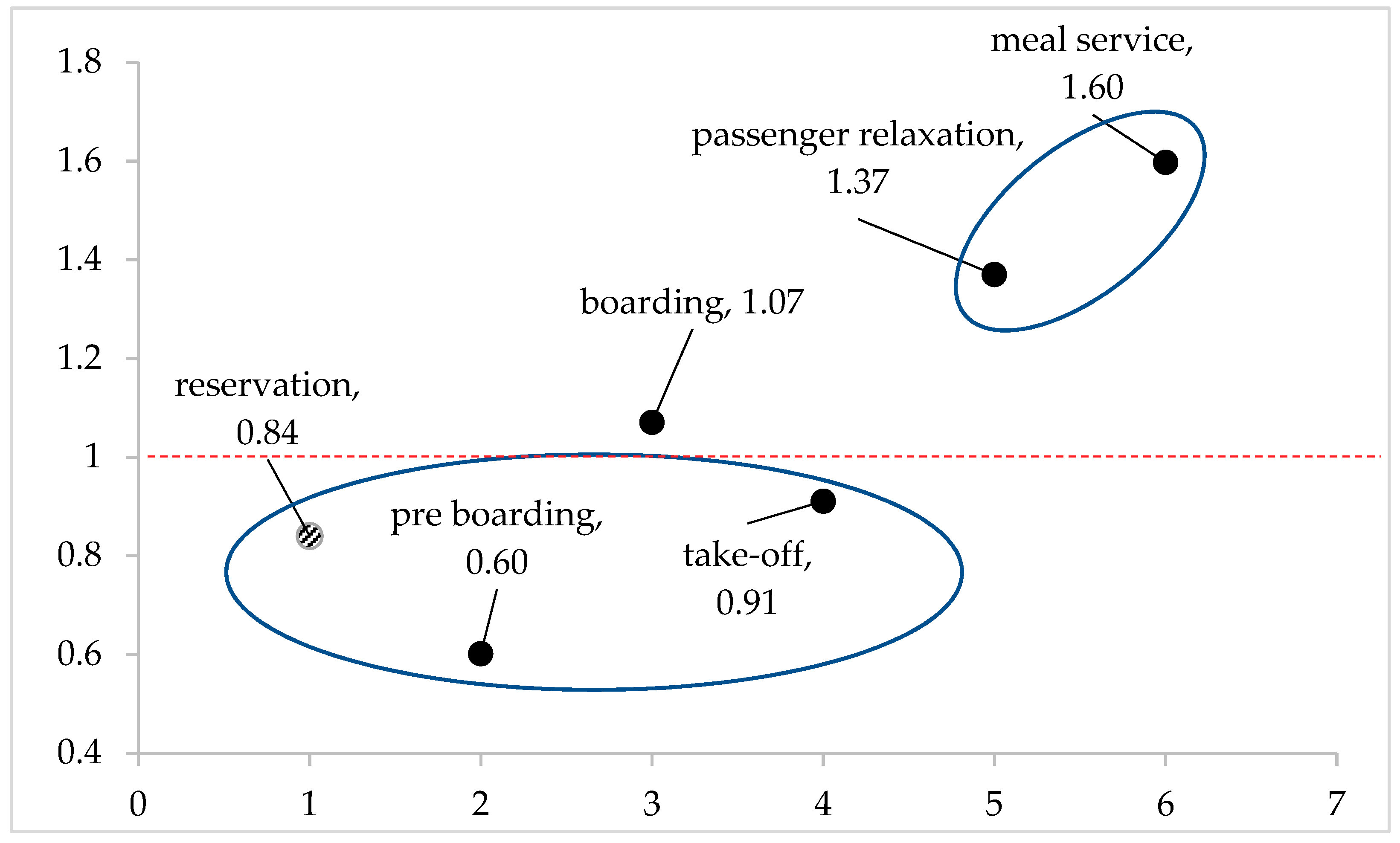
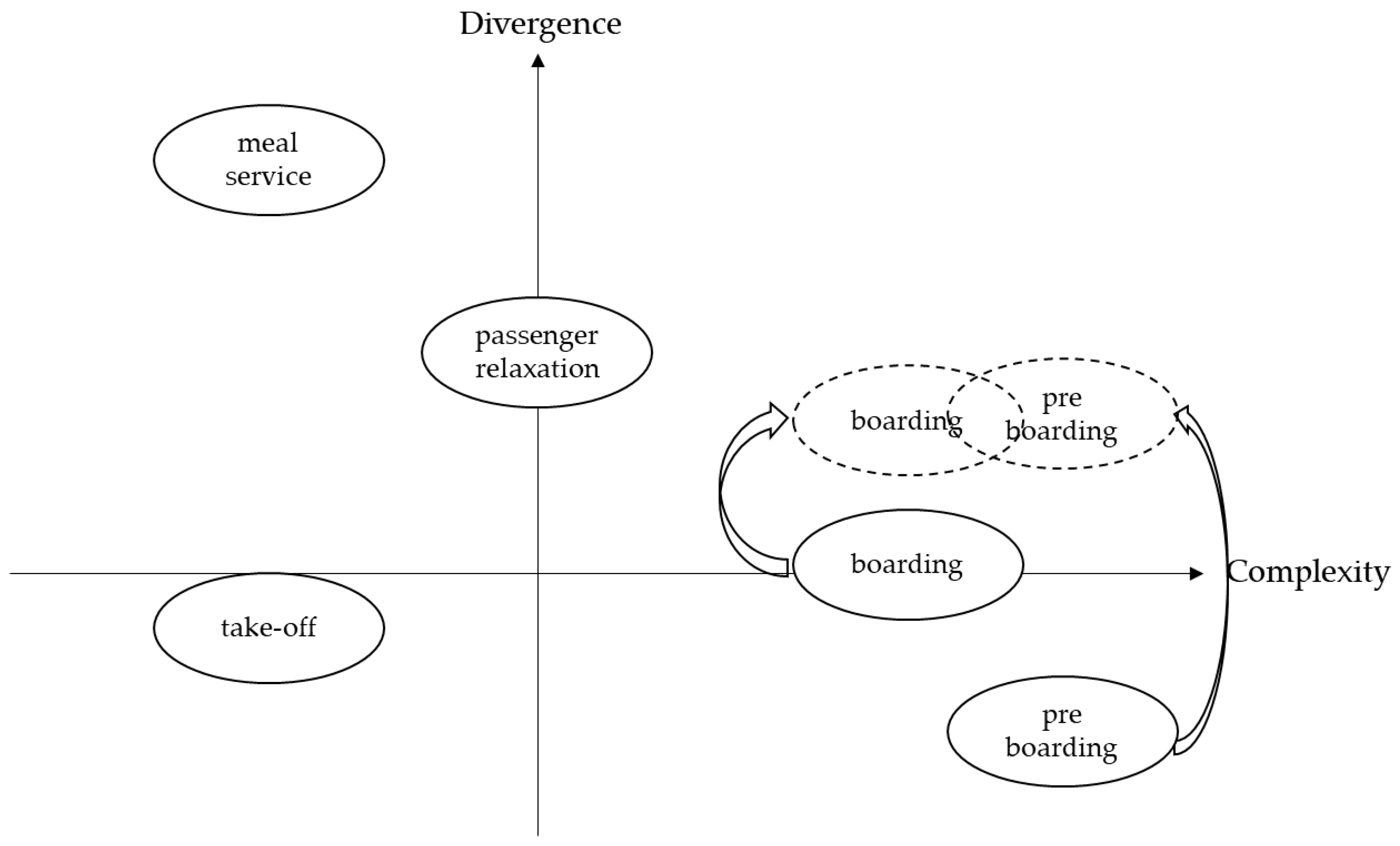
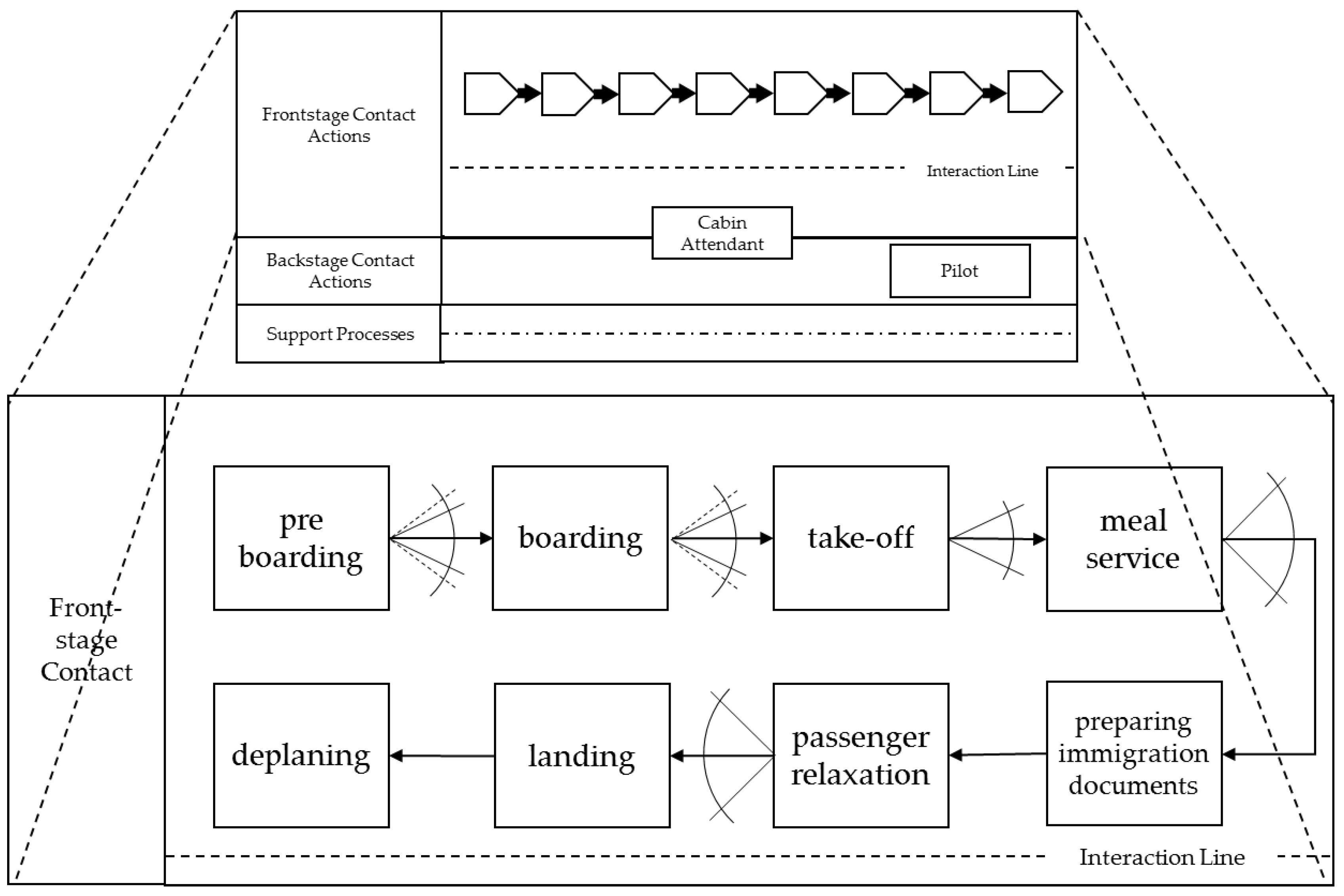
| BR | CA | EK | EY | GA | HU | LH | NH | SQ | QR | |
|---|---|---|---|---|---|---|---|---|---|---|
| Review #s | 1506 | 5377 | 16,200 | 10,789 | 6296 | 350 | 7080 | 1358 | 7960 | 7790 |
| Rank | 6 | 5 | 4 | 8 | 10 | 9 | 7 | 3 | 2 | 1 |
| Service Encounter | Definition | Topics | Importance |
|---|---|---|---|
| Reservation | Related to reservations | T3, T12, T16 | 17% |
| Pre-boarding service (pre-boarding) | Related actions from airport check-in to boarding gate arrival | T5, T7, T9 | 17% |
| Boarding & ground service (boarding) | Related actions from boarding to taking a seat | T2, T17 | 11% |
| Take-off safety check (take-off) | Actions related to take-off and safety check | T14, T15 | 11% |
| Meal & beverage service (meal service) | Actions related to meal service | T6 | 6% |
| Passenger relaxation | Actions related to personal resting and entertaining within a flight | T1, T8, T10, T11, T13, T18 | 33% |
| Deplaning & post-deplaning (deplaning) | Actions related to landing and deplaning | T4 | 5% |
| Benchmark Service Encounters | Topic Modeling Results | Reorganized Service Encounters |
|---|---|---|
| - | Reservation | - |
| - | Pre-boarding service | Pre-boarding service |
| Boarding a plane | Boarding & ground service | Boarding & ground service |
| Finding seats | ||
| Baggage service | ||
| Ground service | ||
| Take-off safety check | Take-off safety check | Take-off safety check |
| In-flight food service | Meal & beverage service | Meal & beverage service |
| In-flight sales | - | - |
| Preparing immigration documents | - | Preparing immigration documents |
| Movie watching | Passenger relaxation | Passenger relaxation |
| Personal relaxing | ||
| Preparing landing | - | - |
| Landing | Landing | |
| Deplaning | Deplaning | Deplaning & post-deplaning |
© 2018 by the authors. Licensee MDPI, Basel, Switzerland. This article is an open access article distributed under the terms and conditions of the Creative Commons Attribution (CC BY) license (http://creativecommons.org/licenses/by/4.0/).
Share and Cite
Nam, S.; Ha, C.; Lee, H.C. Redesigning In-Flight Service with Service Blueprint Based on Text Analysis. Sustainability 2018, 10, 4492. https://doi.org/10.3390/su10124492
Nam S, Ha C, Lee HC. Redesigning In-Flight Service with Service Blueprint Based on Text Analysis. Sustainability. 2018; 10(12):4492. https://doi.org/10.3390/su10124492
Chicago/Turabian StyleNam, Seungju, Chunghun Ha, and Hyun Cheol Lee. 2018. "Redesigning In-Flight Service with Service Blueprint Based on Text Analysis" Sustainability 10, no. 12: 4492. https://doi.org/10.3390/su10124492
APA StyleNam, S., Ha, C., & Lee, H. C. (2018). Redesigning In-Flight Service with Service Blueprint Based on Text Analysis. Sustainability, 10(12), 4492. https://doi.org/10.3390/su10124492





